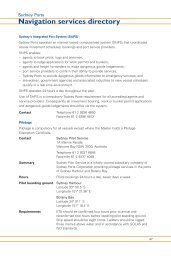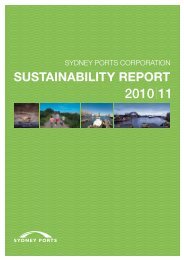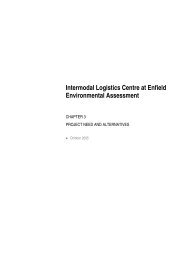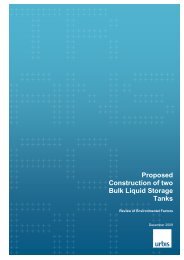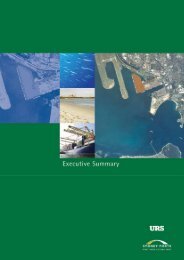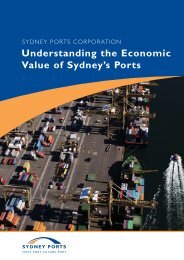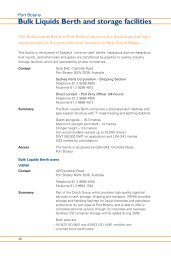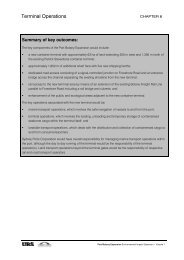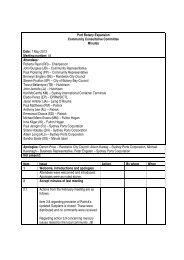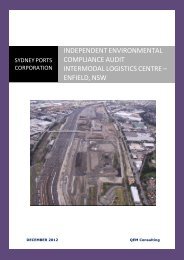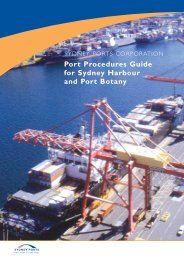SYDNEY PORTS CORPORATION ANNUAL REPORT 12
SYDNEY PORTS CORPORATION ANNUAL REPORT 12
SYDNEY PORTS CORPORATION ANNUAL REPORT 12
Create successful ePaper yourself
Turn your PDF publications into a flip-book with our unique Google optimized e-Paper software.
56<br />
Sydney PortS CorPoration<br />
noteS to the FinanCiaL StateMentS<br />
note 2. SUmmary of SignifiCant aCCoUnting PoliCieS<br />
(ContinUed)<br />
Tax consolidation<br />
The consolidated entity entered the tax consolidation<br />
regime on 1 July 2003. As a consequence, the Corporation,<br />
as the head entity in the consolidated tax group, recognises<br />
current tax payable for the tax group. Amounts receivable<br />
or payable under a tax sharing agreement between the tax<br />
consolidated entities, are recognised as tax related<br />
amounts receivable or payable. Expenses and revenues<br />
arising under the tax sharing agreement are recognised as<br />
a component of income tax equivalent expense.<br />
Other taxes<br />
Revenues, expenses, assets and liabilities are recognised<br />
net of the amount of GST except where the GST incurred<br />
on a purchase of goods and services is not recoverable<br />
from the taxation authority, in which case the GST is<br />
recognised as part of the cost of acquisition of the asset or<br />
as part of the expense item as applicable. Receivables and<br />
payables are stated with the amount of GST included.<br />
The net amount of GST recoverable from, or payable to, the<br />
taxation authority is included as part of receivables or<br />
payables in the statement of financial position.<br />
Cash flows are included in the statement of cash flows on a<br />
gross basis and the GST component of cash flows arising<br />
from investing and financing activities which is recoverable<br />
from or payable to the taxation authority, are classified as<br />
operating cash flows. Contingencies are disclosed net of GST.<br />
Commitments and accrual items that are shown in the<br />
statement of financial position are inclusive of GST<br />
where applicable.<br />
(x) Dividend<br />
The Corporation reviews its financial performance for the<br />
accounting period and recommends to its shareholders an<br />
appropriate dividend payment in light of the current<br />
financial position and longer-term financial commitments.<br />
Under NSW Treasury’s Financial Distribution Policy for<br />
Government Businesses, the Corporation prepares a<br />
Statement of Corporate Intent which is an agreement<br />
between the relevant Ministers and the Board. This<br />
agreement includes dividend targets for the year ahead<br />
and is signed before the end of the financial year to which<br />
it relates. This creates a valid expectation that a dividend<br />
will be paid. Consequently the dividend for the financial<br />
year, if any, is set aside as a provision in the statement of<br />
financial position.<br />
(y) Contingent assets and contingent liabilities<br />
Contingent assets and contingent liabilities are not<br />
recognised in the statement of financial position, but<br />
are disclosed by way of a note and, if quantifiable, are<br />
measured at nominal value.<br />
Sydney PortS CorPoration finanCial rePort 2011/<strong>12</strong><br />
(z) Significant accounting judgements, estimates<br />
and assumptions<br />
The preparation of the financial statements requires<br />
management to make judgements, estimates and<br />
assumptions that affect the reported amounts in the<br />
financial statements. Management continually evaluates its<br />
judgements and estimates in relation to assets, liabilities,<br />
revenue and expenses. Management bases its judgements<br />
and estimates on historical experience and on other various<br />
factors it believes to be reasonable under the<br />
circumstances, the result of which form the basis of the<br />
carrying values of assets and liabilities that are not readily<br />
apparent from other sources. Actual results may differ from<br />
these estimates under different assumptions and<br />
conditions.<br />
The nature of these assumptions and conditions are found<br />
in the relevant notes to the financial statements.<br />
Management has identified the following critical<br />
accounting policies for which significant judgements,<br />
estimates and assumptions are made.<br />
(i) Impairment of non-financial assets<br />
The Corporation assesses impairment of all assets at each<br />
reporting date by evaluating conditions specific to the<br />
Corporation and to the particular asset that may lead to<br />
impairment. If an impairment trigger exists, the recoverable<br />
amount of the asset is determined.<br />
(ii) Valuation of property, plant and equipment<br />
The gross fair value measurement of property, plant and<br />
equipment is determined by independent specialist valuers<br />
and the remaining useful lives of each asset are determined<br />
by the Corporation’s qualified engineers.<br />
(iii) Superannuation<br />
Various actuarial assumptions are required to quantify<br />
the net position of the defined benefit funds. The<br />
determination of superannuation obligations is dependent<br />
on an annual actuarial assessment in accordance with<br />
the accounting policy.<br />
(iv) Taxation<br />
Judgement is required in assessing whether deferred tax<br />
assets and certain deferred tax liabilities are recognised<br />
in the statement of financial position. Deferred tax assets,<br />
including those arising from temporary differences, are<br />
recognised only where it is considered more likely than<br />
not that they will be recovered, which is dependent on the<br />
generation of sufficient future taxable profits. Assumptions<br />
about the generation of future taxable profits depend on<br />
management’s estimate of future cash flows. These depend<br />
on estimates of future revenues, operating costs, capital<br />
expenditure and dividends.



